| Article Date: | May, 2000 |
|
Magazine Volume:
|
23 |
|
Issue:
|
5 |
|
Author(s):
|
Diana Phillips Mahoney |
A hybrid technique for modeling and rendering dynamic liquid adds splash to digital animation
Diana Phillips Mahoney
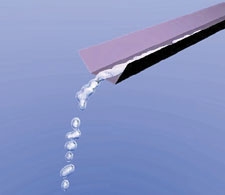 Water,
water everywhere, but not a drop looks real. Trying to create believable
digital water dampens the spirits of animators everywhere. Unlike a solid
object, water is amorphous its appearance varies depending on its environment
and motion state. For example, running water looks different from splashing
water, which looks different from poured or trickling water. As a result,
water is not amenable to traditional polygonal representation. And while
many amorphous phenomena smoke, clouds, and fire, for instance can be believably
modeled using particle systems, dynamic water cannot. This is because water
is not randomly diffuse. Though variable, its form is generally well defined.
Consequently, many animation researchers have poured themselves into the
development of hybrid modeling and rendering techniques that will enable
the realistic representation of liquids in motion.
Water,
water everywhere, but not a drop looks real. Trying to create believable
digital water dampens the spirits of animators everywhere. Unlike a solid
object, water is amorphous its appearance varies depending on its environment
and motion state. For example, running water looks different from splashing
water, which looks different from poured or trickling water. As a result,
water is not amenable to traditional polygonal representation. And while
many amorphous phenomena smoke, clouds, and fire, for instance can be believably
modeled using particle systems, dynamic water cannot. This is because water
is not randomly diffuse. Though variable, its form is generally well defined.
Consequently, many animation researchers have poured themselves into the
development of hybrid modeling and rendering techniques that will enable
the realistic representation of liquids in motion.
A promising effort in this regard is being developed by researchers Alan Murta and James Miller in the Advanced Interfaces Group at the University of Manchester in England. The pair has devised a method for modeling and rendering dynamic fluids that uses a particle system to approximate the behavior of moving liquid and an implicit-surface technique to "wrap" the diffuse particles and enable realistic rendering.
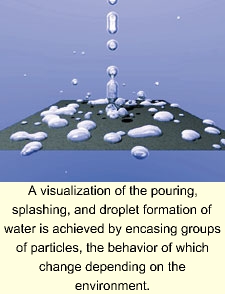 On
their own, each of these techniques is inappropriate for modeling liquid.
While particle systems are useful for modeling amorphous phenomena, they
do so by modeling huge numbers of miniscule, independently acting points.
Thus they are better suited to representing unstructured phenomena such
as fire and smoke than they are to depicting the structured behavior of
fluids.
On
their own, each of these techniques is inappropriate for modeling liquid.
While particle systems are useful for modeling amorphous phenomena, they
do so by modeling huge numbers of miniscule, independently acting points.
Thus they are better suited to representing unstructured phenomena such
as fire and smoke than they are to depicting the structured behavior of
fluids.
In contrast, implicit-surface techniques (metaballs, soft surfaces, "blobbies") can easily describe smooth, intricate forms, but they generally are not able to incorporate the requisite behavioral characteristics of liquid, such as distortions caused by gravity and the ability of droplets to merge and disperse arbitrarily.
The method the Manchester researchers have developed takes advantage of the best of both techniques. "We use a macroscopic model, which features 'large' particles for modeling large accumulations of liquid," says Murta. "These have the capability to dynamically split into several smaller particles should the simulation require it - for example in a high-velocity splash, where many small droplets may be formed." In addition, small particles can fuse into larger ones. The system computes the attractive and repulsive force values of the liquid at given intervals to determine when various particles should and should not coalesce.
All in the Family
The modeling system also supports
the creation of distinct particle "families" to allow the modeling of multifluid
situations, such as the separation of oil and water or the development
of air bubbles within liquid droplets, allowing different physical behaviors
to be implemented across the system. For example, particles can be programmed
to coalesce only with members of their own family, or they can be defined
to exhibit distinct buoyancy behaviors relative to the other families,
such as oil droplets or air bubbles rising to the surface.
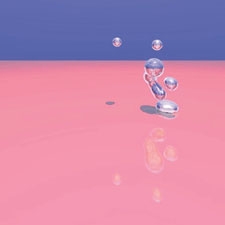 The
particle system also incorporates specialized collision-detection mechanisms
for modeling the the fluid's impact with a solid body. If a particle hits
a surface at high velocity, rules are applied to create a splash. The consequence
of low-speed surface encounters is a sliding effect, whereby the particles
move parallel to the surface.
The
particle system also incorporates specialized collision-detection mechanisms
for modeling the the fluid's impact with a solid body. If a particle hits
a surface at high velocity, rules are applied to create a splash. The consequence
of low-speed surface encounters is a sliding effect, whereby the particles
move parallel to the surface.
Once the particle behavior is defined, an implicit-surface representation is generated, whereby each particle emits a spherical field, and a surface is drawn where the combined field strength of the particles equals some constant value. This isosurface is then rendered using a custom raytracer that tests for intersections between the emitted rays and the surface values.
Because the potential field generated by each particle is spherical, distortion techniques are implemented to represent the shape deformation that takes place when a droplet hits a solid surface. To do this, the system identifies particles that are in contact with solid bodies then applies relative scale and shear distortions to change the shape profile based on the angle at which the droplet hits the surface and gravity.

To maintain the volume of liquid throughout the simulation process, the system automatically adjusts the rendered isosurfaces to reflect the incompressibility of fluids. "Liquids cannot be compressed or stretched, so we wanted our synthetic liquids to maintain a near-constant volume, regardless of their configuration. Otherwise, two distinct droplets would tend to occupy a different volume of space than two merged particles enclosed within a single droplet," says Murta.
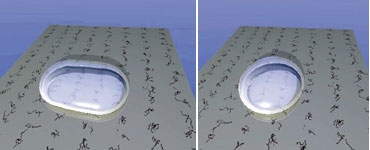
To make the appropriate adjustments, the system computes the "ideal" volume of the particles in a given system. This ideal is determined by first calculating the volume contained within an isolated particle droplet, then scaling that volume by the number of particles in the cluster. "When clusters of particles combine to form larger agglomerations of liquid, we compare the volume enclosed by their shared isosurface with the ideal value produced by this number of isolated particles. We then iteratively adjust the field strength of this particle group in order to grow or shrink its isosurface, stopping when the volume of the result matches the ideal to within some predefined tolerance."
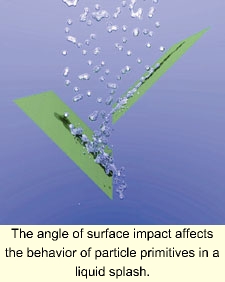 Though
the iterative nature of the system enhances the realism of the final rendered
images, the fact that both the volume-refinement process and the custom
renderer approximate results by replicating series of operations has some
drawbacks. One in particular is the requisite algorithmic complexity, "which
tends to make the rendering method relatively slow," says Murta. Thus,
the technique is limited to non real-time applications.
Though
the iterative nature of the system enhances the realism of the final rendered
images, the fact that both the volume-refinement process and the custom
renderer approximate results by replicating series of operations has some
drawbacks. One in particular is the requisite algorithmic complexity, "which
tends to make the rendering method relatively slow," says Murta. Thus,
the technique is limited to non real-time applications.
Additional technical limitations include the system's inability to produce quality models of settled (vs. dynamic) bodies of liquid because the isosurfaces produced by the particles do not produce the requisite flat horizontal surfaces. Also, says Murta, "our methods for dealing with the interactions of liquid volumes with solid bodies in the scene are fairly rudimentary. For example, a collection of particles inside a drinking glass may emit a field that passes through the glass, and droplet parts may exhibit themselves on the glass exterior." While the system can handle simple arrangements of this sort, complex simulations are beyond its scope.
The Wet Look
In addition to addressing these
issues, the researchers are also considering other enhancements. One is
to make the rendered images look more wet. Right now, says Murta, "the
still images produced by this method do not appear to look particularly
wet, although this could also be argued of high-speed photographs of real
splashing liquids." One way to change this, he suggests, would be to maintain
a history of the isosurface values over time. "Knowing where the droplet
has been in the past allows us to render 'damp patches' in the droplet's
wake. This may help the portrayal of wetness." Another potential enhancement
is the incorporation of such physical phenomena as liquid surface tension.
Though still in its early stages of development, says Murta, this proof-of-concept liquid modeling/rendering system is likely to make waves in the animation world as the demand for realistic computer-generated liquids grows.
Diana Phillips Mahoney is chief technology editor of Computer Graphics World.